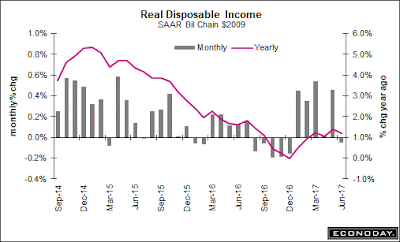Financial FAQs
No economist predicted another 209,000 private payroll jobs would be created in July, or that the last 2 months’ total would be 431,000, or the y-t-d total would be 1,290,000 payroll jobs created this year.
But they should have. The May JOLTS report was an indicator of higher employment numbers, as the unfilled jobs total dropped to 194,000 from 1 million the month before, for a total of 5.472 million hirings in May.
Job gains occurred in food services and drinking places, professional and business services, and health care. Employment growth has averaged 184,000 per month thus far this year, in line with the average monthly gain in 2016 (+187,000), said the Labor Bureau.
The only glitch, if that can be considered a problem, is that wages are still rising at 2.5 percent annually, which means two things. It means consumers won’t buy more than they are already buying, which would in turn increase demand and so increase economic growth, and there’s very little inflation, which means interest rates won’t be rising soon.
Wages aren’t rising faster because there are still many unemployed, or working part time when they would rather be working full time. “Both the unemployment rate, at 4.3 percent, and the number of unemployed persons, at 7.0 million, changed little in July. After declining earlier in the year, the unemployment rate has shown little movement in recent months,” said the BLS.
June’s Real Disposable Income was unchanged and May revised 1 tenth lower to a 0.3 percent gain, as I said in an earlier column. The real problem is weak wage growth, as most jobs being created are in low wage industries, like hospitality and even healthcare. Year-on-year, overall prices are up only 1.4 percent with the core little better at 1.5 percent.
Graph: Econoday
The 3 major employment sectors were Professional and Business Services, Healthcare, and Leisure and Hospitality as usual, all generally lower-paying job sectors.
Employment in food services and drinking places rose by 53,000 in July, said BLS. The industry has added 313,000 jobs over the year. Professional and business services added 49,000 jobs in July, in line with its average monthly job gain over the prior 12 months.
In July, health care employment increased by 39,000, with job gains occurring in ambulatory health care services (+30,000) and hospitals (+7,000). Health care has added 327,000 jobs over the past year.
What are those wages? In July, the BLS says, average hourly earnings for all employees on private nonfarm payrolls rose by 9 cents to $26.36. Over the year, average hourly earnings have risen by 65 cents, or 2.5 percent. In July, average hourly earnings of private-sector production and nonsupervisory employees increased by 6 cents to $22.10.
So the U.S. economy is in a bit of a bind, if it wants to grow faster. And that is a lack of population growth, one of two main drivers of GDP growth, when conservatives want to limit immigration?
The U.S. native population is barely growing, so where else are those workers coming from? And businesses are investing a bare minimum in capital expenditures, robots and other technologies that would increase productivity, the other driver of growth.
And then we have jumped off the Paris Accord bandwagon, when China is tripling its investments in alternative energy sources, such as wind and solar farms. That will also boost productivity and hence growth—for China and the rest of the world that isn’t ignoring climate change.
But conservative still have their heads stuck in coal mines, for some reason. Go figure. What century do they think we are living in?
Harlan Green © 2017
Follow Harlan Green on Twitter: https://twitter.com/HarlanGreen



No comments:
Post a Comment